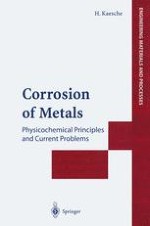2003 | OriginalPaper | Chapter
Galvanic Corrosion Cells
Author : Prof. em. Dr. rer. nat. Helmut Kaesche
Published in: Corrosion of Metals
Publisher: Springer Berlin Heidelberg
Included in: Professional Book Archive
Activate our intelligent search to find suitable subject content or patents.
Select sections of text to find matching patents with Artificial Intelligence. powered by
Select sections of text to find additional relevant content using AI-assisted search. powered by
Two dissimilar metals, A and C, subject to corrosion in the same electrolyte, normally are at different corrosion potentials, (εa)corr and (εc)corr. The electrode system metal C/solution/metal A then is a galvanic cell with the open-circuit voltage (11.1)$$ \Delta \varepsilon = (\varepsilon _c )_{corr} - (\varepsilon _a )_{corr} $$ We choose indices such that (εc)corr is more positive than (εa)corr so that A is the anode and C the cathode in the cell. When short circuited by an external metallic connection between A and C, a cell current, j, will flow, moving positive charge carriers in the solution, and electrons in the metalllic connection, in the direction from the anode to the cathode. The current passing the anode/solution interface has the positive strength +|j|; a current of the same strength but opposite sign, −|j|, passes the solution/cathode interface. At both electrodes the total current, j, is, in principle, the sum of anodic and cathodic partial currents. Often, circumstances are simpler, when at the anode the cathodic partial current of the reduction of an oxidizing species, and/or when at the cathode the partial current of anodic metal dissolution are non-existent or negligible, but this is not the general case. The early assumption that, instead, the action of galvanic cells is the general principle of corrosion in fact has been a source of much confusion.
